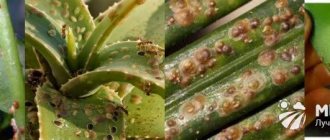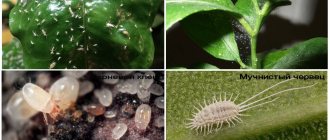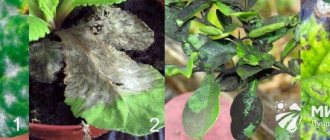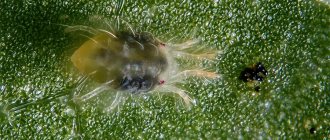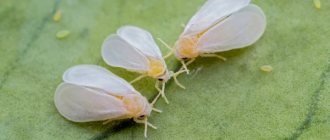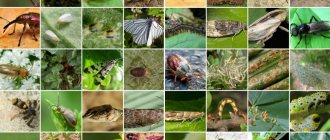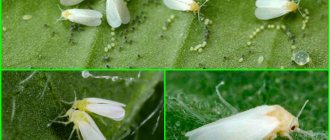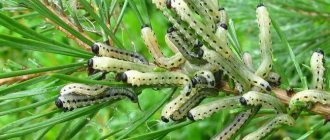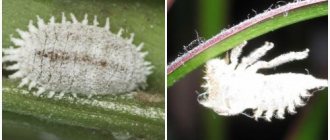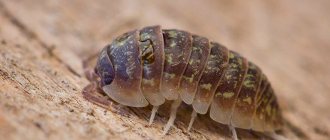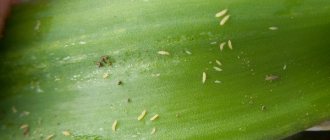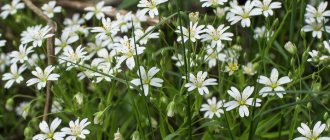Signs of pests
What needs to be done to save pets? First of all, find out what harmful insects have infested the flowers. To do this, a thorough examination of the plant itself and the soil is carried out. After this, they begin a merciless fight using various methods. Remember, any delay is fraught with disastrous consequences.
Insects live in the soil (on roots), on leaves, stems, and gnaw buds.
Plants react to each pest in a special way: they can change the color of leaves and slow down their growth. When visually examining a houseplant, you can notice changes in the leaves and stems.
White spots
White spots are a signal of the appearance of:
- Mealybug or rootbug. You need to examine all parts of the flower. If you notice “cotton” lumps, it means there is a pest.
- When whiteflies appear, the leaves become sticky and may fall off.
- The presence of a red spider (clover) mite can be determined by the whitish mesh, spider mite by the cobweb. Leaves with a large number of insects die off.
Yellow spots
If yellow spots appear on the leaves, you need to inspect the leaves. If fingers stick to them, these are marks left by scale insects. The cause may be the appearance of enchytraea. Tiny white worms live in the soil right at the root.
If you notice the presence of brown, brownish spots on the bottom of the leaf and white smudges on top, this indicates the action of thrips.
Deformation of foliage and stems
If the shoots and leaves on the flowers begin to deform, it means that the flower is affected by aphids or cyclamen mites. Aphids leave behind sticky residues. It sucks the juice from indoor plants, which can cause them to dry out. If dust appears on the leaves below, they curl—the mite is in charge.
The cause of drooping leaves and shoots is fungus gnats, leaf or root-knot nematodes.
Prevention measures
Following the rules for caring for indoor flowers reduces the risk of pests. Each type of plant has its own standards for humidity, lighting, and fertilizing.
Basic Rules:
- optimal temperature conditions;
- watering according to the norm for a specific flower;
- sufficient sunlight or shade;
- regular loosening of the soil for active access of oxygen to the root system;
- fertilizer using organic components and synthetic preparations;
- regular inspection of all parts of the plant to identify pests and diseases;
- drainage system that prevents moisture stagnation;
- timely replanting of the flower if the flowerpot is too small;
- treatment with compounds based on natural ingredients to repel harmful insects;
- inspection of leaves, stems, soil when buying a new plant: often dangerous insects enter the apartment from a flower shop.
Mold, rot and small insects keep plants from living? The following video contains useful tips on how to solve the age-old problem and cure plants from pests and diseases:
Did you like the article? Subscribe to site updates via RSS, or follow updates on VKontakte, Odnoklassniki, Facebook or Twitter.
Subscribe to updates by E-Mail:
Tell your friends!
Yes, there are a lot of pests in houseplants, I now have to fight mealybugs, I tried to manually clean off this sticky cotton wool and wiped everything with a soapy solution to no avail, now I’ve started spraying it with Fufanon
Only Aktara helps against the martyr.
Only Aktara helps against the martyr.
Good afternoon Your photo for the thrips description shows an aphid. Thrips are so small they are difficult to see. Thrips do not live in colonies.
- Author: Maria Sukhorukikh
Rate this article:
- 5
- 4
- 3
- 2
- 1
(0 votes, average: 0 out of 5)
Share with your friends!
What do pests look like?
Pests of indoor plants can cause harm and lead to the death of green spaces if they are not dealt with. Let's look at the most common insects.
Aphid
Aphids can be seen despite their small size. They come in black and green. Insect colonies multiply rapidly: the female lays at least 150 larvae, which after 7 days themselves enter the reproduction stage.
Females of the third generation have the ability to fly. They move onto any indoor plants and lay larvae. Diseases are transferred to flowers on their paws, for example, different types of flower mosaics. Getting rid of aphids is not as easy as it seems.
Shchitovka
Scale insects on indoor plants are a dangerous pest; they love to settle on cuttings, leaves, and stems. It is not difficult to detect: it is flat, oval, with the lower part of its body tightly adjacent to the substrate.
These pests are different. Real scale insects hide under their shells, just like turtles. False scale insects do not have this possibility, since this part of the body is inseparable.
The favorite colors of these pests are:
- lemons;
- oranges;
- tangerines;
- asparagus;
- oleanders;
- ivies;
- palm trees
Scale insects settle on the lower part of the leaf. Colonies develop quickly. Slowly moving dots appear on the leaves, somewhat reminiscent of plaques. The leaves around their habitat turn yellow. Insects suck out the juice of tender plants and shoots, depleting the plant. If you do not start a timely fight, indoor flowers die.
Spider mite
The most common pest of indoor flowers. Characteristic signs of damage: if the leaf is exposed to light, pinpoint punctures, whitish or yellowish, are visible. Gradually they merge into spots. The leaves turn pale and acquire a grayish tint. Then the leaves dry out and completely lose color. This is a typical pattern, but in some cases the leaves turn red or bronze. In some plants, the leaves do not change shape even when the spots are large, in other cases they are severely deformed and curled.
Adult parasites are reddish-brown or greenish in color and difficult to recognize on leaves and stems; females are prolific: hundreds of new eggs appear every three days. Without regular inspection, thousands of mites will quickly drink the juices, and the indoor flower will wither.
Thrips
Small flying insects with an elongated body, the color is a combination of black or dark brown on the top with reddish and yellow in the lower part. The pests are small – no more than 1.5 mm in length; they lay eggs on greenery and do not live in the soil.
It is not difficult to recognize the appearance of thrips: the leaves become grayish-brown below, silvery on top, and there are colonies of tiny pests on the lower part of the leaves.
Parasites drink the juice and deprive the indoor flower of nutritional components. Gradually, the leaves turn yellow, dry out, the buds become covered with small spots and become deformed.
The danger of the pest is not only the lack of nutrition for the affected parts of the plant. Parasites secrete liquid excrement, creating a favorable environment for the development of a serious disease - sooty fungus; with the active reproduction of harmful insects, indoor plants weaken and lose their decorative properties.
Whitefly
Whiteflies are, by and large, greenhouse insects. If you purchased flowers in these places, do not be lazy to examine them carefully. Even one female whitefly on indoor plants will produce huge offspring in a short time. Then the question will arise of how to fight. The pest's favorite flowers are fuchsias, ferns, and geraniums. The two-millimeter insect feeds on plant sap, and as a result it weakens and withers.
Mealybug
The tiny insect is difficult to see without a magnifying glass: its dimensions are no more than 6 mm, its white waxy coating, reminiscent of powder, protects pests from many insecticides.
The destruction of mealybugs requires care, regular treatment of affected flowers; insects settle in the axils of the leaves, entwining the leaves with a thin white cobweb. Optimal conditions for the development of scale insects are high humidity plus a temperature of +25 C, the parasites accumulate in groups, and the leaves seem to be covered with dirty white “cotton wool.”
Most parasites live on stems and leaves and suck out the nutritious juice. Some species parasitize the roots, depriving plants of nutrients. It is no coincidence that amateur gardeners consider the mealybug a dangerous pest: infected plants often die.
Fungus gnats
It often happens that flower growers notice small flies flying around their flowers, but do not attach any importance to it. And in vain, because the fly lays larvae in moist, fertile soil. The larvae are microscopic, so their appearance is not immediately noticeable. The danger of insects is that the smallest creatures feed on the root system of plants. As a result, the flower dies.
Black bugs (panzer mites)
They have a dark brown or black body, often with a shine, and measure about 0.7-0.9 mm. The eggs are tan or brown and also visible to the naked eye. They run away from the light source and immediately hide under leaves, onion scales, or in the soil.
They crawl all over the plant, but eggs are laid on decaying organic matter - fallen leaves, twigs in the ground, a tangle of rotten roots, on already dead yellowing leaves of plants that have not been cut (but only if they are in contact with the surface of the soil).
They develop only in a humid environment, damp soil.
White Podura
This insect can jump and lives directly in pots. It is distinguished by an elongated body, on which sparse hairs are visible. There are antennae on the head. Most often they appear in soils rich in humus.
The basis of nutrition is plant residues, but it does not disdain the living root system. It is clear that the eaten roots can no longer cope with their function, the plant slows down its growth and may die.
Potassium permangantsovka
Treatment with a solution of potassium salt of permanganic acid is the simplest and fastest way to disinfect soil. Three grams of potassium permanganate are dissolved in a ten-liter bucket of water to form a faint pink suspension. The liquid is carefully poured onto the soil to be disinfected, centimeter by centimeter. Potassium permanganate is also used to treat pots and containers for seedlings.
Manganese, when it gets into the ground, saturates it with useful substances - it becomes a fertilizer.
Potassium permanganate is not able to destroy all pathogens, so this method is considered ineffective. To enhance soil disinfection, the container with the treated soil is covered with cellophane film and kept for a week. Under such conditions, pathogenic microflora die, and the soil is saturated with moisture and microelements.
Fighting methods
Many novice gardeners are wondering how to deal with pests of indoor plants. The answer to this is important, since insects multiply rapidly, time must not be wasted.
There are different ways to help get rid of pests:
- mechanical;
- biological;
- chemical;
- folk
If pests of indoor plants are correctly identified, and measures to combat them will be effective.
Mechanical
You need to start with the measures that are safest for humans, especially since they often help a lot. Before starting work, you should disinfect and sharpen your tools. All damaged leaves and shoots are cut off, and the cut areas should be sprinkled with activated carbon.
Bugs and visible larvae are selected manually: scale insects, slugs, caterpillars. Leaves with pests such as aphids can be wiped with a cotton pad. A contrast shower and spraying with water helps get rid of pests living on the green parts of the plant.
It is also possible to immerse the above-ground parts of the affected plant in warm water with a small amount of detergent. In this case, it is advisable to place the pot in a plastic bag and tie it at the top so that the soil does not lock.
Biological
Biological control measures consist of controlling diseases and pests with insecticidal and phytoncidal plant preparations. Most often used:
- "Fitoverm";
- "Agrovertin";
- "Iskra-Bio".
Herbal preparations should be made the main assistants in the fight against pests and diseases of indoor plants. On the one hand, they are environmentally friendly, and on the other hand, they bring real benefits.
Treatment with herbal preparations is carried out in the first half of the day, preferably in the absence of other inhabitants of the apartment. In the evening, before going to bed, the room in which the treatment was carried out is thoroughly ventilated. Individual plants are isolated with plastic film.
Special sprayers are used to spray affected plants. For pollination or dusting, powdered preparations are poured into small gauze bags, which are then shaken over the plant.
Chemical
Chemicals are used in extreme cases. They are considered the most effective, but require strict adherence to safety measures:
- It is necessary to remove all food products from the premises in advance. In warm weather, it is better to treat the affected plant with pesticides in the fresh air, in winter - with the window open.
- During chemical treatment, you should wear a gown and a protective gauze bandage or respirator.
- During chemical treatment, you should not smoke or eat.
- At the end of the chemical operation, you need to thoroughly wash your hands, face and the place where the plant was standing at the time of spraying or dusting with warm water and soap.
- To avoid leaf burn, treated plants should not be placed in the sun until they are completely dry.
- Treated plants should be cared for in the same way as healthy ones.
- All toxic solutions must be prepared in advance.
- Chemicals should be stored in containers with tight-fitting lids, out of the reach of children.
Popular and effective remedies for pests of indoor plants:
- "Karbofos";
- "Chlorophos";
- "Syphos";
- "Trichlorometaphos";
- "Pyrethrum";
- "Decis";
- "Fury."
Folk
If indoor plant pests appear, treatment can be carried out with time-tested folk remedies. For this purpose, decoctions and infusions are prepared from the following plants:
- yarrow;
- chamomile;
- dandelion;
- marigolds;
- nettle;
- garlic;
- Luke;
- peels of oranges, tangerines, lemons.
These environmentally friendly and harmless plants can effectively destroy harmful insects. Steamed citrus peels can be buried in the soil. Insects don't like their smell.
An infusion of tobacco, stove ash, a solution of potassium permanganate, furatsilin or soda works well. To prevent the liquid from immediately draining from the plants, laundry soap is added to it.
Prevention measures
It is not possible to completely protect your indoor plants; it is very important to carry out preventive measures.
- Do not over-moisten the soil;
- Do not leave food, stubs, or plant debris in pots that may begin to rot;
- It is not advisable to experiment with watering with fatty water with sugar or other ingredients that can become a breeding ground for pests;
- Steam purchased or collected soil in the oven;
- Spill the soil once every six months with a disinfectant solution of manganese;
- Once a week, thoroughly wash the trays and window sill with laundry soap without leaving even a residue. After washing, wipe the top with a pest repellent;
- Infected plants should be quarantined, the soil should be changed, and the roots should be washed with running water and a disinfectant.
